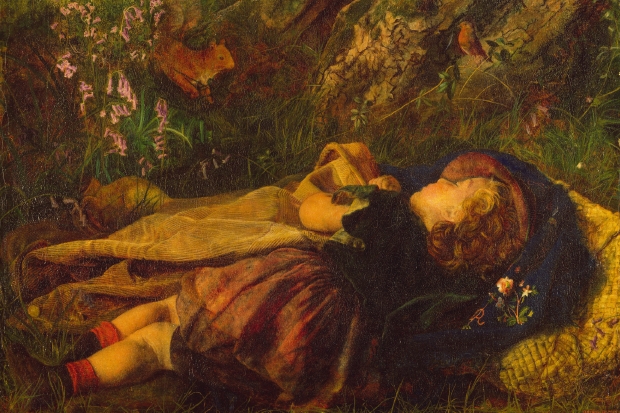Dear, good, kind, sacrificing Little Nell. Here she is kneeling by a wayside pond, bonnet pushed back, shoes and stockings off, while she rests her blistered feet. She scoops a palm of water with cupped hands and tenderly washes those of her grandfather: her feckless, gambling, on-the-lam grandfather. It is an old Oscar Wilde chestnut, but one would have to have a heart of stone to look at William Holman Hunt’s portrait of Charles Dickens’s saintly ‘Little Nell and her Grandfather’ (1845) without laughing.
Likewise Arthur Hughes’s ‘The Woodman’s Child’ (1860), a portrait of a tousle-haired country mite sleeping in the woods, attended by a squirrel and robin, their red coat and breast so sweetly matching her own little ruby socks. Bambi, one imagines, is waiting to gambol into frame.
The Pre-Raphaelites assembled for the Liverpool Walker Gallery’s Pre-Raphaelites: Beauty and Rebellion show do lay the pathos on thick. Titles are twee, treacly or tearful: Daniel Alexander Williamson’s ‘The Startled Rabbit’ (1862); James Campbell’s ‘Twilight — Trudging Homeward’ (1857) and ‘Waiting for Legal Advice’ (1857); John Ingle Lee’s ‘Sweethearts and Wives’ (1860).
Faced with all this Little Nellery, you thrill to the vampish Lady of the Lake in Edward Burne-Jones’s ‘The Beguiling of Merlin’ (1872–7). In clingy, pleated violet and lavender silk she is very beguiling indeed. Looking at Merlin, though, you wonder why she bothers. Lounging on a blossom bough, one hand dangling above a pool of irises, gold-sandalled ankles crossed, he is as drippy as Eddie Redmayne’s Danish girl. Too many of the paintings collected here share Merlin’s languid lack of energy. There’s no vim, no vigour, no get up and go.
The Christ in William Dyce’s ‘Man of Sorrows’ (c.1859)










Comments
Join the debate for just £1 a month
Be part of the conversation with other Spectator readers by getting your first three months for £3.
UNLOCK ACCESS Just £1 a monthAlready a subscriber? Log in